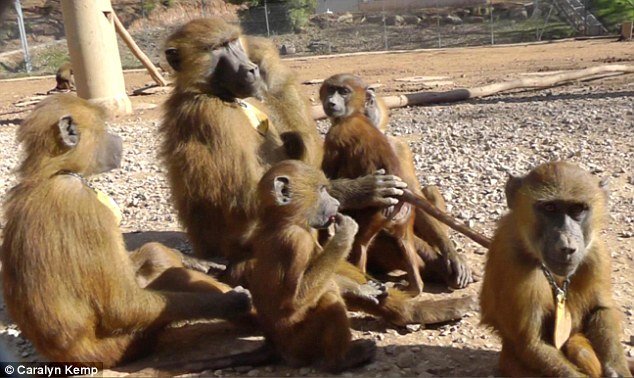Human speech is thought to have come about relatively recently, within the last 70,000 to 100,000 years. Because of this, there has been little research into the links between the sounds made by non-human primates and the way we speak.
But a new study has shown
baboons can make five of the vowel noises thought unique to humans, meaning the origin of language could stretch back much older than we thought - to 25 million years ago.
A new study has shown baboons (pictured) can make five of the vowel noises thought unique to humans
Researchers from Grenoble Alpes University in France, along with other colleagues, studied 1,335 spontaneous sounds produced by 15 male and female Guinea baboons. They found surprising similarities that dates the origin of speech back to our common ancestors, 25 million years ago.
'Similarities between humans and baboons suggest that the vowels of human speech probably evolved from ancient articulatory precursors that were passed on and refined all along the hominid line,' said co-author Joel Fagot from the Université d'Aix in Marseilles. The researchers performed an acoustical analysis of the grunts, barks, wahoos, copulation calls, and yaks from baboons. They found, like people who use several vowels during speech, the non-human primates make five distinct vowel-like sounds.
The researchers analysed 1,335 spontaneous vocalizations produced by 15 male and female Guinea baboons in different social contexts. They also studied the anatomy of vocal tracts from two baboons that died of natural causes.
The results showed baboons produce five sounds that have important similarities with the vowels of human speech.
This goes against a prevalent idea on the origin of speech that says the low, or descended, human larynx is required to be able to produce sets of distinct vowels.
The high larynx of non-human primates was thought to prevent them from producing the vowels found across human languages.
This is not the only evidence suggesting the origin of human speech can be traced back to our shared ancestors.
People form each vowel sound with a precise control of tongue position in the vocal tract, and anatomical analysis revealed that baboon tongues have the same muscles as human tongues.
This suggests these monkeys also use tongue movements to form each of the vowel-like sounds, the researchers said.
Taken together, these findings suggest that spoken language in people may have evolved from articulatory capacities that were already possessed by our last common ancestor with baboons, or about 25 million years ago.
There is an important distinction to be made between the origin of speech, which is thought to date back further than we thought, and the origin of language, the researchers said.
'Our study informs the ability to utter sounds comparable to vowels', Dr Fagot told MailOnline,
But he added, it 'tells nothing on the many other skills, for instance cognitive abilities, that are necessary to develop a language.'

Reader Comments
baboons can talk. We have lots of examples in Congress!
It's the Daily Mail reporting on a study done by a guy named after a bundle of sticks [Link]
I wouldn't be surprised if ventriloquists were involved...
Fake news article in Medieval times:
"Faggots ward off droves of Feygelehs: Obama insists Feygeleh could have been him while Clinton says its deplorable"
At least the scientist had one up on the bully's in HS, they couldn't actually call him one.
Feygeleh - Little bird
[Link]
Oy vey, who would have guessed